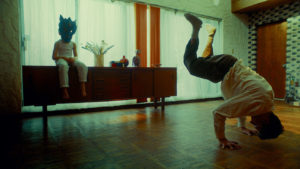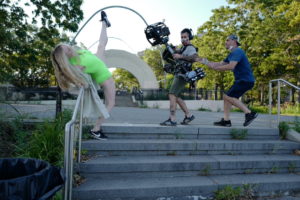Critic’s Choice: A new order of digital from Jacob Jonas The Company - Vancouver Ballet Society
- Home
- Reviews 2020 - 2023
- Critic’s Choice: A new order of digital from Jacob Jonas The Company

By Kathleen Smith
Of necessity, the dancefilm genre exploded during the global pandemic, part of the great digital pivot for artists and dance companies. If the volume of production is astonishing after almost two years, the quality is still all over the place. Dance on film is hard to get right.
Enter Jacob Jonas, a twenty-something dance artist and creative director based in Santa Monica, California. The ambitious series, films.dance, produced by Jacob Jonas The Company, takes a global, entrepreneurial approach to dancefilm, collaborating all over the place to come up with two series of 15 films each made during lockdowns. It’s a wild mix of styles, locales, and dance artists: 400 dancers, 50 choreographers, and a whole bunch of directors in more than 25 countries. Appropriately, the project is sponsored by the travel magazine Somewhere, as well as the Brooklyn Academy of Music and the Soraya performing arts centre in California. Perhaps because the series is well supported, Jonas doesn’t even attempt a paywall — he just puts it all out there freely, for everyone to enjoy. Series one is still available for viewing; series two is currently unrolling through December, one film a week released on Mondays via Vimeo, Instagram, Facebook, and the website films.dance.

It’s a logistical triumph that most of the films are satisfying to watch and technically accomplished. Many adhere to the dancefilm conventions we’ve become familiar with. For example, Match, by New York City Ballet’s Peter Walker and Emily Kikta, employs the tried-and-true technique of shot-matching movement to suggest the interconnectedness of dance artists who are physically isolated from one another. Here, 46 performers (the National Ballet of Canada’s Heather Ogden and Naoya Ebe, and Boston Ballet’s Michaela DePrince, among them) dance their isolation across city streets, public plazas, private gardens, underpasses, balconies — you get the idea. Cleverly edited by Kikta, the work zigzags between performers who play to the camera and those who seem oblivious. The juxtapositions make for a dynamic five minutes.
As performance was shut out of theatres around the world, many of the films set their choreographies around or on urban infrastructure. By contrast, works like Brian Garrick Little’s Biophilia explicitly situate dance in nature. Shot in South Africa, the sets here are forest groves, mud flats, and underwater kelp gardens; whale and elephant cries punctuate Silvan and Stuart Ziegler’s music score. Some of the performers wear elaborate costumes: an insect exoskeleton, large wings made from raffia. Others dress simply in jeans and crop tops. Their dancing is intercut with images of the natural world, or shot reflected in water or against impossibly blue skies. Biophilia’s message about the beauty and our interdependence with the natural world comes through loud and clear.

Many of the films efficiently focus on a single concept done well. A Kiss renders the emotional excitement of connection into physical form, with a surreal subtext of exuberant and dangerous movement. The moody yet exhilarating Box Out uses the physical language and attitudes of the basketball court (the creative team worked closely with East Los Angeles College’s head coach John Mosley) to delineate a power struggle between choreographer/performers Micaela Taylor (the TL Collective) and Jermaine Spivey (Kidd Pivot). And Sit Still depicts how dance (krumping no less) comforts and fortifies a lonely schoolchild danced by seven-year-old Adeline Kerry Cruz.

There’s even a work that touches on the meta-discourse of dancefilm: Another Dance Film, choreographed by Andrea Miller and performed by New York City Ballet star Sara Mearns. The voiceover commentary, delivered as recordings of phone calls of Mearns talking about Miller and vice versa, is a hoot. “I got a few voicemails from Sara,” comments Miller as Mearns dances the heck out of an outdoor amphitheatre stage, “and I don’t really understand anything she’s saying.” Creative differences always have potential for comedy, but the text here also slyly critiques many of the tropes, perplexities, and irritations that continue to dog the form. “People are always searching in dancefilms,” complains Mearns. “You don’t know what they’re searching for and it’s always so annoying.”
Many of the shorter films in the two series are absolutely delicious and/or fun, as well as being compact. Siren, one of my faves and a compelling mix of classical and experimental values that features Royal Ballet principal Francesca Hayward, barely makes it to three minutes. However, the films that go beyond formal or conceptual preoccupations to grapple with something more universally profound are especially compelling.

I loved 正念-NOW, danced by Li Kehua (aka Lico) in the backstreets and derelict spaces of downtown Shanghai, for its glimpses of the history that haunts physical spaces. We carry these spaces and histories within wherever we go — Lico’s performance of the choreography by Gypsy Snider (of Montreal’s 7 Fingers) expresses the pain of this, and the determination needed to carry on.
Also moving — Do Butterflies Remember Being Caterpillars? by the Montreal-based filmmaker Caraz. Working with Luca Patuelli (more familiar to some as the bboy Lazylegz) and choreographer Alessandro Giaquinto, a soloist with Stuttgart Ballet (and featured earlier this year in Dance International), Caraz films the process of growing up as a sometimes-painful transformation bathed in golden light.
When you’re making a dancefilm, it’s rarely enough to just film a dance well. As a producer and team leader, Jacob Jonas seems to be on to something with his expansive, global, and generously collaborative approach to this most niche form of artmaking. The millions of viewers who have been tuning in across platforms to watch films.dance just confirms it.

